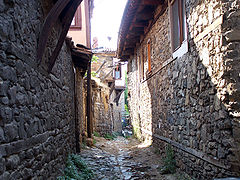
Cumalikizik
Encyclopedia

Ottoman Empire
The Ottoman EmpireIt was usually referred to as the "Ottoman Empire", the "Turkish Empire", the "Ottoman Caliphate" or more commonly "Turkey" by its contemporaries...
's foundation period. The village is within the border of the Yıldırım
Yildirim
Yıldırım is a metropolitan district in the centre of Bursa in Turkey. The district was named after Ottoman Sultan Bayezid I. It was founded in 1987 and it has a size of 399 km². The Sultan Bayezid I's nickname was Yıldırım, which means thunderbolt in Turkish.-Location:Yıldırım, which is...
county. Cumalıkızık was founded by a waqf village. The historical texture of the village has been well protected and the civilian countryside architectural structures of the early Ottoman
Ottoman Empire
The Ottoman EmpireIt was usually referred to as the "Ottoman Empire", the "Turkish Empire", the "Ottoman Caliphate" or more commonly "Turkey" by its contemporaries...
period are still intact. Because of this, Cumalıkızık has become a popular but still unspoiled center for tourists.
A group of similar villages which are placed close together between the foot of mount Uludağ
Uludag
Uludağ , the ancient Mysian Olympus, is a mountain in Bursa Province, Turkey, with an altitude of . It is a popular center for winter sports such as skiing, and a national park of rich flora and fauna...
and the valleys have been called kızık in Turkish. The name stands for one of the twenty-four clans of the Oghuz Turks
Oghuz Turks
The Turkomen also known as Oghuz Turks were a historical Turkic tribal confederation in Central Asia during the early medieval Turkic expansion....
and the people from the villages also called kızık. Similar villages, less well preserved, are Değirmenlikızık, Derekızık, and Hamamlıkızık. Hamamlıkızık was the village of the local baths (hamamli), and Cumalıkızık was named because people gathered there on Friday (Cuma, in Turkish)for worship.
The Cumalıkızık ethnography museum in the village's square displays historical objects from the village. Every June there is a raspberry festival. The famous Cumalıkızık houses are made out of wood, adobe
Adobe
Adobe is a natural building material made from sand, clay, water, and some kind of fibrous or organic material , which the builders shape into bricks using frames and dry in the sun. Adobe buildings are similar to cob and mudbrick buildings. Adobe structures are extremely durable, and account for...
, rubble
Rubble
Rubble is broken stone, of irregular size, shape and texture. This word is closely connected in derivation with "rubbish", which was formerly also applied to what we now call "rubble". Rubble naturally found in the soil is known also as brash...
stones. Most of them are triplex houses. The windows upstairs are generally latticed
Latticework
Latticework is a framework consisting of a criss-crossed pattern of strips of building material, typically wood or metal. The design is created by crossing the strips to form a network...
and with a bay window
Bay window
A bay window is a window space projecting outward from the main walls of a building and forming a bay in a room, either square or polygonal in plan. The angles most commonly used on the inside corners of the bay are 90, 135 and 150 degrees. Bay windows are often associated with Victorian architecture...
. The handles and knockers on the main entry doors are made of wrought iron
Wrought iron
thumb|The [[Eiffel tower]] is constructed from [[puddle iron]], a form of wrought ironWrought iron is an iron alloy with a very low carbon...
. Cobblestone streets are very narrow with no sidewalks, but a typical medieval gutter in the center for rain and waste water.
A mosque
Mosque
A mosque is a place of worship for followers of Islam. The word is likely to have entered the English language through French , from Portuguese , from Spanish , and from Berber , ultimately originating in — . The Arabic word masjid literally means a place of prostration...
, the fountain of 'Zekiye Hatun' next to the mosque and a bath with one dome are original from the Ottoman Empire
Ottoman Empire
The Ottoman EmpireIt was usually referred to as the "Ottoman Empire", the "Turkish Empire", the "Ottoman Caliphate" or more commonly "Turkey" by its contemporaries...
. Also there is a ruin of a church built by Byzantines
Byzantine Greeks
Byzantine Greeks or Byzantines is a conventional term used by modern historians to refer to the medieval Greek or Hellenised citizens of the Byzantine Empire, centered mainly in Constantinople, the southern Balkans, the Greek islands, Asia Minor , Cyprus and the large urban centres of the Near East...
.
Cumalıkızık holds 270 historical houses. Some of these houses are in process of restoration and maintenance, and 180 of them are still being used as dwellings.
In 1969, the remains of a Byzantine church were unearthed southeast of the village in the foothills of Mt. Uludağ. Some architectural works are on display in the Archeological Museum of Bursa. Movies and television programs with historical settings have often been recorded in Cumalıkızık.

